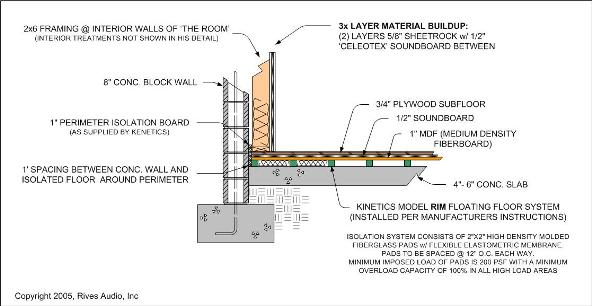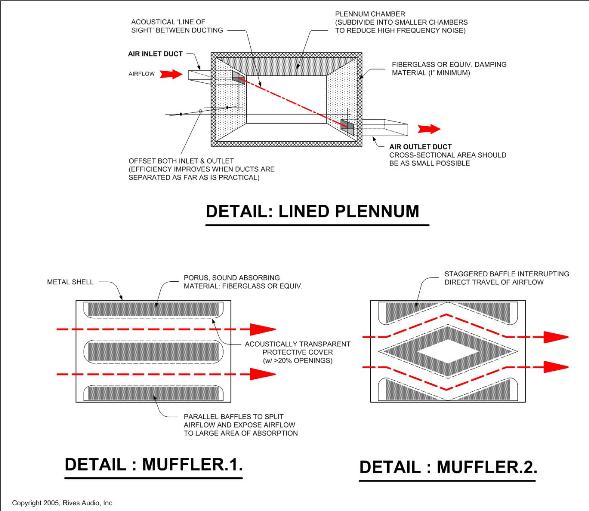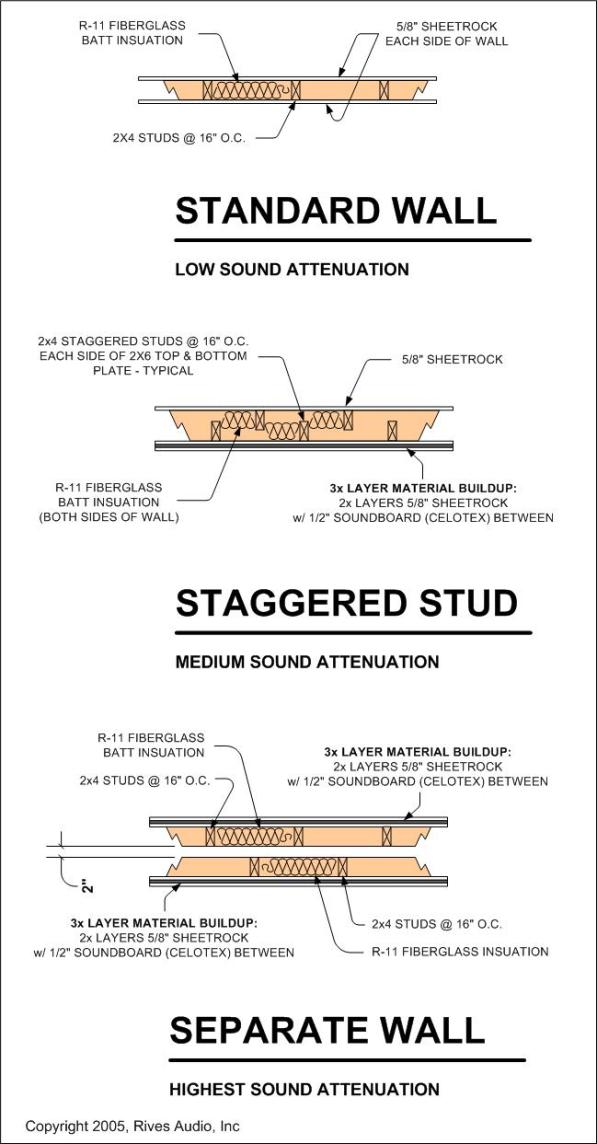“A chain is only as strong as its weakest link.”
This is a very appropriate saying with regard to sound isolation. We are often asked questions like: “What can I do to this wall to stop the sound going through to the bedroom on the other side?” It’s almost incomprehensible to people that the wall may not be (and probably isn’t) the only part that is leaking sound to that bedroom. The other parts might well be the floor, the ceiling joists and other shared walls. You could make changes and increase the STC (Sound Transmission Coefficient) dramatically for that wall, but the result might be marginal because the majority of the sound is getting through elsewhere.
In order to deal with sound control one should understand how sound travels. In residential environments it will either be air borne or structure borne. Air borne sound is pretty simple – this is what we hear within the room. A combination of air borne and structure borne approaches need to be considered for sound isolation. One may ask, “But if the room is sealed, isn’t all the air borne sound contained?” To a point the answer is yes, but a ½ inch layer of gypsum is not going to stop 50 Hz, just slow it down (i.e. attenuate) and it could become both an air borne wave and a structure borne vibration in the next room.
Let’s look at structure borne sound. Have you ever been in a room on a concrete slab where someone is bouncing a golf ball 2 or 3 rooms away? If you are standing on the same concrete slab with no breaks in it, you will hear that golf ball almost as if you were in the same room. You are not getting any air borne sound transmission, this is all structure borne. Many people think that having a high mass will stop all sound, but actually sound travels faster in dense material than in air. The golf ball experiment shows us that mass does not stop the sound at all, rather it transmits it to other parts of the house–quite efficiently too.
So what do we do if we want to isolate sound? The answer is quite simple: Only two things stop sound – mass and space. You need mass to contain the airborne sound, but then you also need space (an air gap or similar unobstructed area) so that the structure borne sound can not be transmitted. You may have heard of sound isolation techniques such as staggered stud walls or resilient channels. These work on those principles – there is a high mass wall, an air gap, and then another wall, making sound transmission difficult.
Simple, right? Well in principle yes, but the devil is in the details. You have to figure out how to actually execute a plan that attacks “the weakest link” effectively. Let’s say you’re designing a recording studio and there’s a train track outside the studio. Well first, it might be smart to consider finding a new location for your studio, but if that fails what are you going to do? You’re going to need a lot of mass to stop the noise from a train, like a concrete block building, but structure borne vibration is going to get through that, so you will need an air space and a second high mass wall. How much air space and what type of wall? This is where acoustical engineers come into place, where they can measure what the problem is and at what frequencies and then calculate what size air gap and what mass (walls et cetera) are needed. So you’ve built that great wall, you should be fine right? Hold it – not so fast. What about the ceiling? You have to use a similar technique there. Now there are doors and windows to deal with. You will need to have “sound locks” to ensure that sound does not penetrate there. So now you’ve taken care of the walls, the doors, windows, and ceiling. You have a concrete bunker that a nuclear warhead could land next to and everyone would be safe inside. Can you hear the train inside our bunker? You bet! What did you do to the floor? Nothing. The vibration from the train goes right through the ground, into the concrete slab, and right into our studio. You’ve just built the most expensive fallout shelter known to man, because it’s worthless as a recording studio. Your weak link was the floor, and with all the right intentions – nothing was done about it – and to fix it is going to be very expensive.
Fortunately, this was fictional. I don’t think anyone has built a serious recording studio next to a railroad track, but there have been many studios built near highways, and floor vibration is very real and very important.
When considering sound isolation there are really 2 aspects. Keeping sound out of the listening environment, and retaining sound within the listening environment. You would think that if you had one you would necessarily have the other, but that’s not always the case. First consider the level of noise and the source of noise that might get into the listening environment. Is there a busy road outside? Is there a hard surface floor above the room where people walking will be heard? What about the HVAC (heat and air conditioning system)? Is it a duct system and will sound travel through those ducts, as well as the noise generated by the HVAC system itself? Now we have to determine what type of noise problems are probable with each of these. Are they structure borne, such as a person walking in the room above, or are they air borne such as HVAC generated noise?
Structure born noise is often the hardest to deal with. You need, as stated above, a high mass and an air space, so that there is no positive structural contact. In the case of the hard floor above the listening environment you will need to decouple the floor joists from the ceiling joists. The most common and effective way to do this is to use spring loaded isolation hangers. Companies such as Mason Industries and Kinetics make these isolation hangers which are suitable for creating a suspended high mass dry wall ceiling (see fig 1). That is not to be confused with the typical suspended ceiling, which has very little mass and will not stop sound from penetrating into or out of the room very effectively.

Now let’s look at another type of structure noise – the busy road outside. You might think this is air borne and it could very well be. That noise will penetrate windows quite effectively, but if you are in a basement on a concrete slab, there may be more noise that comes in from vibration. In recording studios this is particularly important and it needs to be dealt with. Kinetics makes a product called a RIM Floating Floor system (see fig 2). This system rolls out onto the sub floor and then you build a standard floor above it. It has a resonance frequency of around 4 Hz, so anything in the audible bandwidth will not penetrate through it, if it is installed correctly. A subfloor (2x ¾” plywood layers or more), the walls, and the final finished floor can all be built on this floor isolation system.
Fig 2
Finally, let’s look at air borne noise. This typically comes through thin walls, windows, or as stated previously, the HVAC (one of the most common overlooked issues in a good home theater design). Duct work is like an open channel to transmit sound – a ‘flanking path’ in Acoustical terms. Have you ever talked in one room and been heard quite clearly in another room, halfway across your house? Were you close to a HVAC duct when this occurred? So what can you do about this type of noise? Actually, it’s relatively simple to reduce noise of this type from various parts of the house simply by adding a baffle box and/or plenum that is lined with absorbing material to both the trunk and return of the HVAC unit. A baffle box is basically a large box that has at least two 180 degree turns or a combination of turns to give essentially the equivalent. A plenum is kind of like a muffler, not as effective as the baffle box, but much better than nothing (see fig 3). The second aspect of the HVAC system is the noise it generates by moving air through the ducts and in and out of a room, and the noise of the motors and fans of the unit itself. Most households have relatively small ducts for the volume of air moved. It’s fine for most residential applications, but not for our critical sound areas. We need to oversize the ducts and more importantly oversize the diffusers where the air exits into the room. Typically we like to have air velocity into the room less than 225 CFM (Cubic Feet per Minute). An HVAC contractor can calculate the load required for the room and the amount of air exchange needed, and determine the diffuser together with the duct size needed to achieve this. If your HVAC contractor looks at you and asks, “how do I do that?”, get another HVAC contractor. It’s also a good idea to line the last several feet of ductwork with a sound absorbing material.
Fig 3
Now we have some of the basics covered, let’s look at few more areas. First is the interior high mass structure, namely the walls. How will these be constructed so that there is a high mass interiorly and an air gap, a physical space between the two elements of mass? There are many ways to accomplish this. First you need to create the high mass; this can usually be accomplished by using 3 layers of material, generally 2 layers of gypsum with “some” interior layer that they sandwich. I say “some” because there are many interior layers that are suitable depending on the needs of the room. We won’t go into the details of these different interior layers, but in general they can be broken down into two categories: Homasote or Celotex, a low density sound board, or a damping layer such as ASC Iso blocks or Audio Alloy’s “Green Glue”. The second aspect is the air gap, which can be done either by a resilient channel, or by creating a separate or staggered stud wall. The greater the air gap and the higher the mass, the better the isolation will be. (see fig 4).
Fig 4
So are we done? Not quite. Windows and doors need to be considered. These are an equally important part of the ‘sound envelope’ and, as such, can be major sources of sound leakage. They provide another ‘flanking path’ for unwanted sound. Again, the best way to stop sound is to have (I’ll say it again) mass, and air gap (physical space), and mass. So, with windows it would be great if we could have two sets of windows with very thick or substantial laminated glass in each and a nice air gap between them. This is often impractical and we have to look at something more reasonable. A pre-manufactured thermopane window with laminate glass inserts can do a reasonably good job of sound isolation. The laminate glass is basically glass with a thin layer of acrylic bonded to it. This acrylic bonding element between the two pieces of glass reduces the ability of the glass to freely vibrate at their fundamental frequencies, thereby reducing both the ringing artifact from the glass and their ability for effective sound transmission. It’s not a perfect solution by any stretch, but it’s reasonably priced and is much better than standard glass.
Doors are another area of concern. Those hollow core doors with ¾ inch gap at the bottom found as the interior doors in most homes are just about worthless in terms of sound isolation. You would probably do as well to have a curtain hanging there instead of that door. Sound isolation for doors parallels the cost of the doors. A solid core door will provide more sound isolation, but it still leaks quite a lot at the threshold. An exterior door, with good weather striping and a threshold to seal it when it’s closed is better yet. There are doors with a “cam” hinge closure that really seals them shut and offer terrific sound isolation, and if you really want to go for broke, you can always buy a recording studio door, that resembles something like a bank vault door (and costs nearly as much too). The latter is really pretty impractical and virtually never required for residential applications, but I wanted to mention the possibilities just the same. One very clever way of dealing with the door issue is to have what’s known as a sound lock. This basically is a small entry area, where there is a door to, for instance, the home theater and another door to the rest of the house. This provides the air gap that is effective at sound isolation. When we use solid core doors with good quality weather stripping and a threshold, this creates excellent sound isolation.
There – now we’ve covered everything. Ceiling, walls, floor, windows, doors, HVAC. Surely there can’t be anything else. Wrong again. There are still two more things to consider in the acoustical criteria of the design: Lighting and Electrical. You have to get these elements into the room, but you don’t want to compromise the sound isolation. Electrical boxes should be sealed enclosures and there should not be another box on the opposite wall within the same joist. This is a common pitfall to sound isolation because every electrical contractor knows it’s easiest to put electrical outlets for adjoining rooms on a common wall in the same joist bay. Less wire, less work, less cost–don’t let them do it this way for the home theater – Another ‘flanking path’. You will have just compromised a lot of the hard work and effort you put into sound isolation. Lighting is another caveat. We never use recessed cans in a high mass sound barrier – period. Sometimes we use them in soffits that are not part of the sound barrier. In fact, we sometimes create soffits just for the sole purpose of holding necessary lighting fixtures and/or HVAC ducting, so as to avoid compromising the sound isolation envelope of the room. However, I can not tell you how many times the home owner goes to the electrician and says “You know I think I’d rather have recessed lights here than track lighting.” The electrician obliges, and guess what? Well – all that expense you put into creating a sound barrier was just thrown away because it’s now been compromised by a bunch of 8 inch holes for lighting.
Okay, that’s enough. But before I sign off I would like to emphasize one aspect of the electrical and lighting issues. You can see that execution of a design is as important as the design itself. If it’s not done right, you may have started with the best intentions and ended with very poor results. Make sure your designer/architect or engineer is in close communication with the builder to ensure that the plans are carried out properly. Without that critical communication it is unlikely that the result will be very rewarding.
By Richard Rives Bird and Christopher Huston of Rives Audio.

































